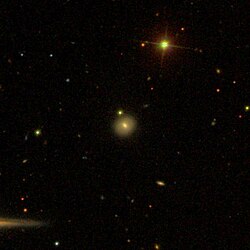NGC 321
| Galaxie NGC 321 | |
|---|---|
 | |
| SDSS-Aufnahme | |
| AladinLite | |
| Sternbild | Walfisch |
| Position Äquinoktium: J2000.0, Epoche: J2000.0 | |
| Rektaszension | 00h 57m 39,2s [1] |
| Deklination | −05° 05′ 10″ [1] |
| Erscheinungsbild | |
| Morphologischer Typ | E/SB0?[2] |
| Helligkeit (visuell) | 15,0 mag[2] |
| Helligkeit (B-Band) | 15,7 mag[2] |
| Winkelausdehnung | 0,4′ × 0,3′[1] |
| Positionswinkel | 95°[2] |
| Flächenhelligkeit | 12,5 mag/arcmin²[2] |
| Physikalische Daten | |
| Rotverschiebung | 0.016161 ± 0.000150[1] |
| Radialgeschwindigkeit | (4845 ± 45) km/s[1] |
| Hubbledistanz H0 = 73 km/(s • Mpc) | (219 ± 15) · 106 Lj (67,2 ± 4,7) Mpc [1] |
| Durchmesser | 25.000 Lj[3] |
| Geschichte | |
| Entdeckung | Albert Marth |
| Entdeckungsdatum | 27. September 1864 |
| Katalogbezeichnungen | |
| NGC 321 • PGC 3443 • MCG -01-03-43 • IRAS F00550-0521 • 2MASX J00573925-0505098 • GC 5130 • NPM1G -05.0031 | |
NGC 321 ist eine linsenförmige Galaxie vom Hubble-Typ E-SB0 im Sternbild Walfisch, welche etwa 219 Millionen Lichtjahre von der Milchstraße entfernt ist.
Die Galaxie wurde am 27. September 1864 von dem deutschen Astronomen Albert Marth entdeckt.[4]
Trivia
NGC 321 ist Reiseziel in der Star-Trek-Folge „Krieg der Computer“, wird aber dort als Planetensystem bezeichnet.[5]
Weblinks
Einzelnachweise
Auf dieser Seite verwendete Medien
Autor/Urheber: Sloan Digital Sky Survey, Lizenz: CC BY 4.0

Angle of view: 4' × 4' (0.3" per pixel), north is up.
Details on the image processing pipeline: https://www.sdss.org/dr14/imaging/jpg-images-on-skyserver/